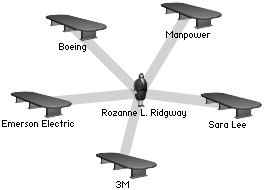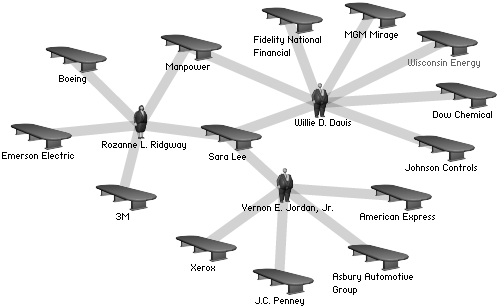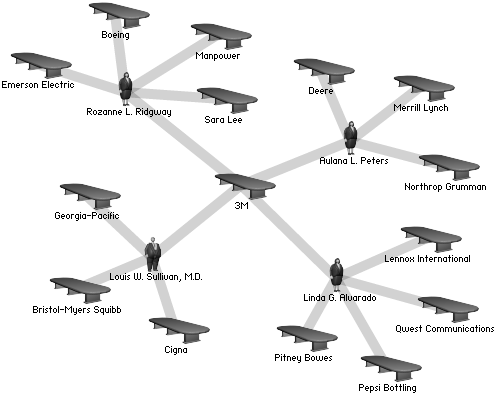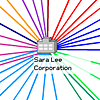| |
Interlocking Directorates in the
|
|||||||||||||||||||||||||||||||||||||||||||||||||||||||||||||||||||||||||||||||||||||||||||||||||||||||||||||||||||||||||||||||||||||||||||||||||||||||||||||||||||||||||||||||||||||||||||||||||||||||||||||||||||||||||||||||||||||||||||||||||||||||||||||||||||||||||||||||||||||||||||||||||||||||||||||||||||||||||||||||||||||||||||||||||||||||||||||||||||||||||||||||||||||||||||||||||||||||||||||||||||||||||||||||||||||||||||||||||||||||||||||||||||||||||||||||||||||||||||||||||||||||||||||||||||||||||||||||||||||||||||||||||||||||||||||||||||||||||||||||||||||||||||||||||||||||||||||||||||||||||||||||||||||||||||||||||||||||||||||||||||||||||||||||||||||||||||||||||||||||||||||||||||||||||||||||||||||||||||||||||||||||||||||||||||||||||||||||||||||||||||||||||||||||||||||||||||||||||||||
 |
| Citigroup interlocks (click to expand) |
We might as well start with Citigroup -- the largest commercial bank in the United States as of 2005 -- and the 25 corporations it is linked to. This colorful diagram is made possible courtesy of the "Board Analyst" tool on TheCorporateLibrary.com. It shows how 13 people create "interlocks" (also called "links" or "network ties") between Citigroup and 25 other corporations. Two of the 25, Alcoa and Comcast, share two directors with Citigroup, so they have a "double interlock." None of the 25 corporations linked to Citigroup is a bank because interlocks between companies in the same business sector are illegal due to past agitation about the possible negative effects of interlocking directorships.
Next we can look at the interlocks among the 25 companies that interlock with Citigroup, an analysis that is based on all the directors of these corporations. The linkages are first presented in Table 1 in a form that makes them easy to understand. Notice that most of the companies are not interlocked with each other. Twelve companies have only one or two links to the other 25. Two companies, Pepsico and EDS (zillionaire H. Ross Perot's data management company), have six interlocks.
| Table 1: The connections among the 25 corporations linked to Citigroup (based on all directors of the |
| Company (# of connections) | Connected companies |
|---|---|
| 1. Aetna (4) | American Air Lines, Comcast, Electronic Data Systems, Lucent |
| 2. Alcoa (4) | DuPont, Johnson & Johnson, Lucent, PepsiCo |
| 3. American Airlines (4) | Aetna, Comcast, Electronic Data Systems, Time Warner |
| 4. AT&T (2) | Calpine, Halliburton |
| 5. Automatic Data Processing (1) | Johnson & Johnson |
| 6. Calpine (2) | AT&T, Hallburton |
| 7. Comcast (4) | Aetna, American Air Lines, Electronic Data Systems, Hospital Corp. of America |
| 8. Cummins Engine (2) | Raytheon, Schlumberger |
| 9. DuPont (2) | Alcoa, Hospital Corp. of America |
| 10. Electronic Data Systems (6) | Aetna, American Airlines, Comcast, Halliburton, PepsiCo, Target |
| 11. Estée Lauder (2) | Ford Motors, Time Warner |
| 12. Ford Motors (1) | Estée Lauder |
| 13. Halliburton (5) | AT&T, Calpine, Electronic Data Systems, Lyondell, PepsiCo |
| 14. Hospital Corp. of America (2) | Comcast, DuPont |
| 15. Johnson & Johnson (4) | Alcoa, Automatic Data Processing, Lucent, PepsiCo |
| 16. Lucent (5) | Aetna, Alcoa, Johnson & Johnson, PepsiCo, Time Warner |
| 17. Lyondell (2) | Halliburton, Raytheon |
| 18. PepsiCo (6) | Alcoa, Electronic Data Systems, Halliburton, Johnson & Johnson, Lucent, Target |
| 19. Raytheon (3) | Cummins, Lyondell, Schlumberger |
| 20. Schlumberger (3) | Cummins, Raytheon, United Technologies |
| 21. Target (4) | Electronic Data Systems, PepsiCo, Xerox, Yum! Brands |
| 22. Time Warner (3) | American Airlines, Estée Lauder, Lucent |
| 23. United Technologies (1) | Schlumberger |
| 24. Xerox (1) | Target |
| 25. Yum! Brands (1) | Target |
Table 2, below, presents the entire matrix, so that you can see there are relatively few links: only 37 out of 300 possible connections.
| Table 2: The interlocks among the 25 corporations that are interlocked |
| 01 | 02 | 03 | 04 | 05 | 06 | 07 | 08 | 09 | 10 | 11 | 12 | 13 | 14 | 15 | 16 | 17 | 18 | 19 | 20 | 21 | 22 | 23 | 24 | 25 | |
| 01. Aetna | x | x | x | x | |||||||||||||||||||||
| 02. Alcoa | x | x | x | x | |||||||||||||||||||||
| 03. American Airlines | x | x | x | x | |||||||||||||||||||||
| 04. AT&T | x | x | |||||||||||||||||||||||
| 05. Automatic Data Proc. | x | ||||||||||||||||||||||||
| 06. Calpine | x | x | |||||||||||||||||||||||
| 07. Comcast | x | x | x | x | |||||||||||||||||||||
| 08. Cummins Engine | x | x | |||||||||||||||||||||||
| 09. DuPont | x | x | |||||||||||||||||||||||
| 10. Electronic Data Sys. | x | x | x | x | x | x | |||||||||||||||||||
| 11. Estée Lauder | x | x | |||||||||||||||||||||||
| 12. Ford Motors | x | ||||||||||||||||||||||||
| 13. Halliburton | x | x | x | x | x | ||||||||||||||||||||
| 14. HCA | x | x | |||||||||||||||||||||||
| 15. Johnson & Johnson | x | x | x | x | |||||||||||||||||||||
| 16. Lucent | x | x | x | x | x | ||||||||||||||||||||
| 17. Lyondell | x | x | |||||||||||||||||||||||
| 18. PepsiCo | x | x | x | x | x | x | |||||||||||||||||||
| 19. Raytheon | x | x | x | ||||||||||||||||||||||
| 20. Schlumberger | x | x | x | ||||||||||||||||||||||
| 21. Target | x | x | x | x | |||||||||||||||||||||
| 22. Time Warner | x | x | x | ||||||||||||||||||||||
| 23. United Technologies | x | ||||||||||||||||||||||||
| 24. Xerox | x | ||||||||||||||||||||||||
| 25. Yum! Brands | x | ||||||||||||||||||||||||
| TOTAL | 4 | 4 | 4 | 2 | 1 | 2 | 4 | 2 | 2 | 6 | 2 | 1 | 5 | 2 | 4 | 5 | 2 | 6 | 3 | 3 | 4 | 3 | 1 | 1 | 1 |
 |
| Citigroup interlocks via NetDraw (click to expand) |
For my purposes here, however, this matrix is just a way station on the path to a visual representation of the full network, which includes the interlocks between Citigroup and each of the other 25 corporations. This network was created by Nicholas Harrigan of Australian National University using the graphic visualization software called "NetDraw," available from www.analytictech.com. (The two darker lines in the diagram represent the double interlocks with Alcoa and Comcast, which were mentioned earlier.)
We also can determine the interlocks that the 153 directors of these 25 companies create with still other companies. According to TheCorporateLibrary.com, they are also directors at an additional 214 corporations. From this example, it is easy to see why researchers claim there is one big corporate community based on interlocking directorates.
 |
| J.P. Morgan interlocks (click to expand) |
However, to make sure Citigroup is not atypical, we can glance at another big and important bank in 2005, J.P. Morgan Chase. What makes this bank a little extra interesting is that J. P. Morgan was the infamous financier of 100 years ago whose financial companies were said to control dozens of corporations, and probably did (Chernow, 1990). As for the "Chase" part of the name, the Chase Manhattan Bank was the home base for the huge Rockefeller fortune from the 1930s until fairly recently. Sure enough, J.P. Morgan has links to 23 other companies, including double interlocks with Honeywell and Merck.
It's also noteworthy that two companies, Ford Motors and Yum! Brands, have interlocks with both Citigroup and J.P. Morgan Chase, which of course means there are organizational links between those two large banks.
 |
| Citigroup non-profit links (click to expand) |
It's also possible, thanks to TheCorporateLibrary.com, to examine the links between corporations and various nonprofit organizations, such as foundations, think tanks, and charities. Some social scientists say these nonprofits are part of a "Third Sector," implying they are an independent force separate from private corporations and government, but I think they are mistaken. The nonprofits are linked to the corporate community, not only by the interlocks shown below, but by financial gifts from the corporations as well. To the right is the nonprofit network around Citigroup created by its directors.
 |
| J.P. Morgan non-profit links (click to expand) |
And here's the nonprofit network created by directors of J.P. Morgan Chase.
Just to add to the complexity of these nonprofit links, let's note that there are eight organizations that are in both the Citigroup and J.P. Morgan Chase networks, which means eight more organizational links between the two banks in addition to the two created by Ford Motors and Yum! Brands. I'll leave it to you to spot those eight organizations if you are into that sort of thing, except to say that one of them, Catalyst, is dedicated to helping women advance in the corporate community.
Corporate Centrality
"Centrality" is a concept with two components, a large number of interlocks, plus the degree to which those interlocks are with other companies with a large number of interlocks. In the past, banks were invariably the most central organizations in the corporate network, but not any more. In a study of centrality using interlocking directorates among 100 corporations and 109 nonprofits, Citigroup and J. P. Morgan Chase, both headquartered in New York, were among the 10 most central organizations, but they were joined by Sara Lee in Chicago and 3M in St. Paul, which by coincidence were the 104th and 105th largest corporations on the Fortune 500 list a few years ago (Moore, Sobieraj, Whitt, Mayorova, & Beaulieu, 2002, Table 3). According to TheCorporateLibrary.com, in 2004 Sara Lee had ten directors who linked to 31 other companies, which in turn linked to 267 companies, and 3M had 11 directors who linked to 31 other companies, which in turn linked to 297 more companies. In looking at the Sara Lee and 3M networks, keep an eye out for any companies they might share in common.
|
|
So what is going on here? How did these two relatively minor corporations move to the center of the network? Before I provide the answer, which is very simple, and has to do with diversity and multiculturalism, it will be useful to look briefly at the history of interlocks.
A quick history of interlocks
The first corporate directors, and interlocking directors, appeared in the 1790s in the incorporation papers for New England textile mills owned in common by subgroups of wealthy men who were part of an overall group. So, to take a hypothetical example, Persons 1, 2, and 3 owned Company A, and Persons 1, 4, and 5 owned Company B, Persons 2, 3, and 6 owned company C, and so on. In this case it is clear that the interlocking directors are also common owners. We also know that these people sat together on bank boards very shortly thereafter, if not immediately. By 1845 a group of 80 men, known to historians as the "Boston Associates," controlled 31 textile companies that accounted for 20 percent of the nationwide textile industry. Seventeen of these men served as directors of Boston banks that owned 40 percent of the city's banking capital, 20 were directors of six insurance companies, and 11 sat on the boards of five railroad companies (Dalzell, 1987). It is very likely that these interlocks were used to coordinate the operations of these corporations and to look out for the overall interests of the general ownership group.
Thanks to economist David Bunting's (1983) important original archival research on the origins of the American corporate network, we also know that the major banks and insurance companies in New York City were already tightly interlocked by 1816. In fact, the 10 largest banks and 10 largest insurance companies were linked into one network by their interlocking directors. In 1836, all but two of the 20 largest banks, 10 largest insurance companies, and 10 largest railroads were linked into one common network, with 12 of the 38 companies having an amazing 11 to 26 interlocks, 10 having 6 to 10 interlocks, and 16 having one to 5 interlocks. Even at that time, which is often romanticized as one of small businesses, the 10 largest banks had 70 percent of the bank assets in New York City and 40 percent of the bank assets in the entire state. Most interlocking directors were major capitalists in those days, and were using their directorship positions to coordinate their interests as much as possible.
Bunting (1983) and sociologist Bill Roy (1983; 1997) then carry the story to the early 20th century, showing that most large banks, insurance companies, railroads, and manufacturing companies were part of one big corporate network. But as the 20th century unfolded, things became more complicated. Laws were passed outlawing interlocks among competitors. There were more and more hired managers, and they began to be included on corporate boards. Some rich families, like the Rockefellers, hired people to sit on corporate boards for them. So, the corporate network now included more than just owners and financiers. Still, it remained intact, with banks at the center.
In addition, there was one other subtle change going on. The bankers were less likely to sit on the boards of manufacturing companies, as they did when there was almost surely banker dominance in many corporations. Instead, the heads of the manufacturing companies, sometimes men who had worked their way to the top, went to sit on the bank boards. Maybe banks were becoming places of coordination rather than power centers (Mizruchi, 1982; Mizruchi, 1983). By this point many corporations were thought by scholars and journalists to be just as powerful as commercial and investment banks.
An interview I did in the early 1980s with a retired CEO of a major bank can give us a sense of what boards looked like at that time to a person who was a member of several of them.
Talking with a corporate director about board composition
Frederick G. Larkin was the friend of a friend, or actually, kind of a foster parent or mentor to my friend. A graduate of the Stanford Business School in 1936, he had just retired as the CEO of Security Pacific Bank, where he had worked his way up the executive ladder. I told him I just wanted to ask him about his board experience, and he agreed to an interview. We met on the top floor, the umpteenth floor, of the Security Pacific skyscraper in Los Angeles, which was not a happy setting for me due to a mild height phobia. At noon we walked down a short inside stairs to a fine lunch in the large (and nearly empty) executive dining room. I think he was candid, maybe because my questions were not all that probing, but I also had promised confidentially on the names of the people he talked about. Along the way, he vented about how environmentalists, trade unionists, and prying journalists were screwing everything up.
When I asked about why the various members were on his bank board, it was clear that they were a mix of owners, highly regarded customers, corporate lawyers, and executives whom he respected. Two were people of note in the business world that he thought added luster and visibility to the board. I had not been able to find information on one of the women on the board, but he explained that she was a member of the Chandler family, the super-wealthy family that owned the Los Angeles Times, among other things.
When I asked about the boards of other companies he sat on, he confidently stated why he thought each person was on the board. For example, with one small oil company, long since merged out of existence, there were one or two big shareholders, along with a lawyer representing another major owner, and financial advisors. At a company clearly controlled by the owning family, where a son was in charge, the other board members were the company's commercial banker (i.e., Larkin), investment banker, and lawyers, along with two or three executives whose judgment was respected by the owner/CEO.
When we finished he got on an elevator to the roof and took off in a helicopter for the Los Angeles Airport, heading for a meeting of the Federal Reserve Bank of San Francisco. (And yes, he was a member of the Bohemian Club.) I took a cab to the airport, relieved that he hadn't offered to give me a ride from that scary setting that I couldn't have handled.
Then things changed somewhat
In the late 1980s and 1990s, banks began to lose some of their centrality. They were still more central than most companies, but they did not have the extensive interlocks they had in the past (Barnes & Ritter, 2001; Davis & Mizruchi, 1999). From my perspective, several things seem to be going on at once. For one, big owners and big financiers are no longer the main board sitters. For another, top-level executives are sitting on each other's boards. There are also some retired political figures who provide entrée to Washington. But there's another issue. Starting in the 1960s, and picking up real steam in the 1980s, corporations were under pressure to diversify their boards in terms of adding women and people of color. My colleague Richard L. Zweigenhaft and I have spelled out this story in great detail (Zweigenhaft & Domhoff, 2003, Chapter 7; Zweigenhaft & Domhoff, 2006; Zweigenhaft & Domhoff, 1998).
However, for all the diversification that has occurred, most corporate directors are white males. The highest diversification figures are for the top 100 corporations, where white men held 71%, of the directorships in 2004, women of any color held 17%, African-
(Brief research digression: For anyone who might want to do more research on this issue in a year-by-year fashion for 1987 through 1998, there is an untapped resource that sits in many libraries as well as in the money-raising offices at large universities. Created by Jeannette E. Glynn, a retired librarian for the Bank of America, it's called Who Knows Who. It has two main sections, "Director-to-Director Links" and "Organization-to-Organization Links," for 1,066 corporations and 112 foundations by 1998. The Director-to-Director section provides the companies and fellow directors for each director of the corporations and foundations that are included, and the Organization-to-Organization section lists each corporation's corporate and foundation connections, along with the name of the person who creates the link. There is also a section that lists directors by the number of boards they sit on and a section that lists corporations by the number of organizational links they have.)
 |
| Rozanne Ridgway |
So now we return to Sara Lee and 3M. They have many interlocks with other corporations and have moved to the center because they both have women and African-
In telling this story, I am going to move back and forth between two websites, TheCorporateLibrary.com and They Rule, whose databases are for slightly different years, and thus would show slightly different results if you compared them for yourself, due to the fact that the composition of boards can change slightly each year. With that caution in mind, here's the interlock network created by Ridgway based on the five corporate boards she sits on in the TheyRule.net database:

|
|
Next let's consider two other people on the Sara Lee board with Ridgway. First, there's Vernon Jordan, an African-
If we add Jordan and Davis to the Ridgway diagram -- once again using the superb tools available on TheyRule.net -- we can see why Sara Lee is near the center of the corporate network. Recalling my quick nonmathematical definition of "centrality," Sara Lee is near the center because it has numerous interlocks with companies -- such as 3M, Boeing, and American Express -- that have numerous interlocks of their own.

|
|
|
It is also interesting to look at the interlocks created by three atypical directors who sit on the 3M board with Ridgway. Aulana Peters is an African-

We also can stop for a minute to look at the interpersonal connections that a Ridgway and a Davis have by virtue of their presence on corporate boards. That is, we can see the social networks created among people who have a common board membership as a "link." These interpersonal networks become relevant for the conclusion that I draw in a minute. For this demonstration, we return to the database on TheCorporateLibrary.com:
|
|
As these several different examples show, it seems that since the 1990s the corporate network has been based first and foremost on the individual qualities of the people asked to join several corporate boards rather than on the desire for any formal organizational relations between corporations. There are still some owners, financial advisors, and legal advisors on many boards, as in the old days. But there are also fellow executives who are liked or respected, along with former government officials or political confidants who provide connections in Washington. And then there are the women and people of color who add diversity as well as expertise and connections. Zweigenhaft and I (1982, pp. 25-43; 1998, p. 191) summarize the situation by saying the boards are now made up of owners, executives, lawyers, financial advisors, ambassadors, buffers, and tokens.
This leads to the best current conclusion about corporate interlocks by three business school professors who study boards. The "small world" of the corporate community is created by a combination of the interpersonal ties and expertise of the people who already sit on one or more boards. This generates a community of directors who are not sitting on two or more boards for the purpose of cementing ties between the companies, i.e., with what is called "strategic intent" in the quote that follows, but because they have experience with the kinds of issues that boards face:
"The upshot of these studies is that board interlocks may be a fortuitous by-product of board preferences for recruiting experienced directors, with little strategic intent (with the possible exception of bank ties), yet the result is the creation of a network that is highly consequential for board decision making. The prior experience of directors is part of the raw material of board decision making, and it is thus unsurprising that a director who has been involved in acquisitions, alliances, adopting takeover defenses, creating an investor relations office, or any other board-level decision (including recruiting other directors) would bring that expertise to bear; indeed, it would be bizarre if things were otherwise." (Davis et al., 2002, p. 305)
One further piece of evidence for this conclusion is the fact that corporate connections "broken" by the death or retirement of a director are not very often "restored" by a new director chosen from closely related companies, which is what would be expected if directorships were still used to establish relationships between companies (Koenig & Gogel, 1981; Palmer, 1983). This finding helps explain why the centrality of corporations can change every few years. When Ridgway, Jordan, and Davis leave the Sara Lee board, for example, the company could drift to the periphery of the network.
Does the interlock network still have an organizational function?
Although most directors probably are not selected for "strategic" reasons, the network of interlocking directors still has some inter-organizational utility. In particular, new ideas can diffuse from one company to another fairly easily. For example, if a director at corporation A sees that the company's new research unit is functioning quite well, she might suggest that a similar research unit be adopted at other companies on whose boards she sits. In turn, directors from those companies may carry the idea to still other companies.
However, I don't want to make too much of the overall network in terms of any given director's comprehension of it. It is too big and diffuse for any one person to see it whole unless they look for connections in big reference books (which is actually what Who's Who in America, Standard & Poors Register of Corporations and Directors, and the Martindale-Hubbell Law Directory are for from the point of view of the business world). Subjectively speaking, it doesn't mean much, if anything, to any individual that Company A is linked to Company D through Company A's link to Company B and Company B's link to Company C and Company C's link to Company D. Only students of interlocking directorships know that fact. It's a little overly simple, but think of it in terms of your own social networks. Obviously, you know your friends, and you often know some of their other friends, although not all of them, as you often learn to your surprise at a reunion, wedding, or funeral. But you certainly don't know the friends of these "friends of friends," i.e., the people who are three steps removed from you (you -> your friends -> their friends -> their friends).
What's in it for the interlocking directors?
Why do people agree to become directors of two or more corporations? For most of them, it's too easy for us to say that they make good money, anywhere from tens of thousands to a few hundred thousand per board, because those high levels of compensation are fairly recent. It's more likely that they receive various intangibles out of it, such as prestige, information, and new connections. Based on his interviews with corporate directors, sociologist Michael Useem (1984) concluded that service on two or three corporate boards widened the horizons of top executives, which he called "business scan." He also showed that those who sit on two or more corporate boards are more likely to be in policy-discussion groups and to receive appointments to government advisory committees (Useem, 1980). Thus, becoming a director, and then an interlocking director, can help move a person to the heart of the power structure. This finding recently has been supported by a sophisticated "small world" analysis of the interlocks among corporations, foundations, policy-discussion groups, and cultural organizations for the years 1962 to 1995 (Barnes, 2005).
It is very likely that similar motives are operative for the women and people of color who have joined corporate boards since Useem did his study. Moreover, if they serve on five or six corporate boards, they can make over $500,000 a year going to several meetings once a month. (Directors who are on crucial board committees may spend more time.)
Conclusion
The study of interlocking directors has been useful to power structure researchers in helping us to define the corporate community and to learn something about how boards function. These studies show that many corporate leaders don't just sit at their home corporation attending to their own business. Through meeting together on boards of directors, those who are interlocking directors develop social cohesion and shared perspectives to go with their economic power bases.
I believe this is why such people are the core of the leadership group for the upper class and the corporate community, which I call the "power elite." However, as the cases of Sara Lee and 3M show, we should not make too much out of the exact "shape" of the interlock network at any given moment because too much can change when the corporate network is no longer made up strictly of owners and financiers who are using their directorships to coordinate their economic interests.
References
Barnes, R. C. (2005). The multiple dimensions of the corporate elite's "Small World" from 1962 to 1995. Paper presented at the American Sociological Association, Philadelphia.
Barnes, R. C., & Ritter, E. R. (2001). Networks of corporate interlock: 1962-1995. Critical Sociology, 27, 192-220.
Breiger, R. L. (1974). The duality of persons and groups. Social Forces, 53, 181-190.
Bunting, D. (1983). Origins of the American Corporate Network. Social Science History, 7, 129-142.
Chernow, R. (1990). The House of Morgan. New York: Atlantic Monthly Press.
Dalzell, R. F. (1987). Enterprising elite : the Boston Associates and the world they made. Cambridge, Mass.: Harvard University Press.
Davis, G. F., & Mizruchi, M. S. (1999, June). The money center cannot hold: Commercial banks in the U.S. system of corporate governance. Administrative Science Quarterly, 44, 215(212).
Davis, G. F., Yoo, M., & Baker, W. (2002). The small world of the American corporate elite, 1982-2001. Strategic Organization, 1(3), 301-326.
Koenig, T., & Gogel, R. (1981). Interlocking Corporate Directorships as a Social Network. The American Journal of Economics and Sociology, 40(1), 37-50.
Mizruchi, M. S. (1982). The American corporate network, 1904-1974. Beverly Hills: Sage Publications.
Mizruchi, M. S. (1983). Relations Among Large American Corporations, 1904-1974. Social Science History, 7, 165-182.
Moore, G., Sobieraj, S., Whitt, J., Mayorova, O., & Beaulieu, D. (2002). Elite interlocks in three U.S. sectors: Nonprofit, corporate, and government. Social Science Quarterly, 83, 726-744.
Palmer, D. (1983). Interpreting corporate interlocks from broken ties. Social Science History, 7, 217-231.
Roy, W. G. (1983). Interlocking directorates and the corporate revolution. Social Science History, 7, 143-164.
Roy, W. G. (1997). Socializing capital: The rise of the large industrial corporation in America. Princeton: Princeton University Press.
Useem, M. (1980). Which Business Leaders Help Govern? In G. W. Domhoff (Ed.), Power Structure Research (pp. 199-225). Beverly Hills: Sage.
Useem, M. (1984). The inner circle: Large corporations and the rise of business political activity in the U.S. and U.K. New York: Oxford University Press.
Zweigenhaft, R., & Domhoff, G. W. (1982). Jews in the Protestant Establishment. New York: Praeger.
Zweigenhaft, R., & Domhoff, G. W. (2003). Blacks in the white elite: Will the progress continue? Lanham, MD: Rowman and Littlefield.
Zweigenhaft, R., & Domhoff, G. W. (2006). Diversity in the power elite: How it happens, why it matters (Second ed.). Lanham, MD: Rowman and Littlefield.
Zweigenhaft, R. L., & Domhoff, G. W. (1998). Diversity in the Power Elite: Have Women and Minorities Reached the Top? New Haven, CT: Yale U Press.
This document's URL: http://whorulesamerica.net/power/corporate_community.html
All content ©2024 G. William Domhoff, unless otherwise noted. Unauthorized reproduction prohibited. Please direct technical questions regarding this Web site to Adam Schneider.









 mobile/printable version of this page
mobile/printable version of this page